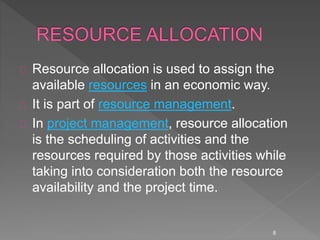Resource planning and resource allocation
- 1. Presented by : VENUMADHAV.R.YEMUL Guided by : MILIND.D.DARADE Roll No : 5073 1
- 2. Manpower, equipment, and materials are important project resources that require management attention. The basic objective of resource planning and resource allocation is to supply and support the field operations. The term resource allocation is used in the case where required resources are assigned such that available resources are not exceeded. 2
- 3. Resources are the means of production needed to complete a project. Most project managers would consider the big three resources that will require your attention to be: ŌĆó Material ŌĆó Labor ŌĆó Equipment 3
- 4. A. LABOUR a. In the limited resource allocation case, there are two assumptions: (1) There are a fixed number of crews available to perform the work and (2) The project may be delayed as a result of the limitation of crews. The objective of the resource allocation problem is to determine when the project will be completed. 4
- 5. b. In the unlimited resource leveling case, there are two assumptions: (1) There are an unlimited number of crews available to perform the work and (2) The project may not be delayed. The objective of the resource leveling problem is to determine how to limit the fluctuation in crews required on the job. 5
- 6. B. MATERIALS Materials, for projects with sufficient on-site storage, are delivered to the site and assumed to be available to workers as needed. A material-related concern for sites that have sufficient space is that of optimizing the position of materials on the site so that they require the least travel time from the lay-down yard to the work-face. 6
- 7. C. EQUIPMENTS There are various types of equipment used on construction sites. Some of this equipment should be considered in the project plan, some need not be included. Workers, and their companies, are typically required to provide the small tools needed to complete their specific features of work. There are some types of equipment, however, that can affect the overall sequence and duration of the project. 7
- 8. Resource allocation is used to assign the available resources in an economic way. It is part of resource management. In project management, resource allocation is the scheduling of activities and the resources required by those activities while taking into consideration both the resource availability and the project time. 8
- 9. Resource planning cannot be accomplished without four essential resources necessary to accomplish the given scope of work: ŌĆó MATERIAL ŌĆó MAN POWER ŌĆó MACHINARY ŌĆó TIME 9
- 10. Human resources for construction planning breaks down into three major categories as follows: ŌĆó Home office personnel(Administrative Persons) ŌĆó Construction personnel (field supervision and labor) ŌĆó Construction subcontractors(Electrification, Plumbing, etc) 10
- 11. The ideal form of a personnel loading curves is a trapezoid. The average personnel loading curve is a straight line. Actual practice loading curves take the shape of a bell curve 11
- 12. 12
- 13. The latter two result when the personnel loading curves occur earlier or later than planned on a project. Front loaded curve- the work started as early as possible. Normal loaded curve- the work started at normal time. Back loaded curve- the work started as late as possible. 13
- 14. The "S" curve for the ideally loaded project has a gradual start and finish, which indicates smooth starting and finishing conditions. The forward loaded curve shows a rapid project start up and an even more gradual than normal phase out at the end. The backward-loaded project indicates a more relaxed start and a very steep finish slope on the "S" curve. 14
- 15. 15
- 16. 16
- 17. Ensuring that the material resources for the project arrive on time involves these important planning areas: ŌĆó Long-delivery equipment ŌĆó Special materials and alloys ŌĆó Common materials in short supply ŌĆó Services and system requirements ŌĆó Transportation systems 17
- 18. Resource Limited: The project must be finished as soon as possible, but without exceeding some specific level of resource usage or some general resource constraint 18
- 19. 1. When the schedule demands more workers per day than are available or if we have workers standing around without jobs, we have a problem. 2. When a new hire is trained, there is loss of productivity. So, if we can keep the trained people and reduce the number of new hires, we should be better off. 19
- 20. . As we know, every project suffers from start-up problems of some sort. Superintendents and project managers are very busy trying to get everybody working in a productivity manner. Therefore, if we can start with a small crew and increase its size gradually, we will eliminate some of the start-up problems. . Most projects suffer from congestion around project completion time because of reduced work areas. Thus, if we can gradually reduce the crew size as we approach project completion, we can improve productivity by reducing congestion. 20
- 21. The leveling procedure are as follows: ŌĆó Scheduling all the critical jobs first. ŌĆó Starting the non-critical jobs whenever there is a drop in scheduled man power upto the point where the peak is reached. ŌĆó Starting the non-critical jobs whenever there is a drop so that no ups and downs occur in the resource profile. 21
- 22. ŌĆ║ Time Limited: The project must be finished by a certain time, using as few resources as possible. But it is time, not resource usage, that is critical 22
- 23. Resource Histograms: ŌĆó A bar chart showing the amount of time assigned to a resource for the time interval. ŌĆó Resource availability is depicted as a line for comparison purposes. ŌĆó Resources assigned more work than available hours are considered ŌĆ£over-allocatedŌĆØ. 23
- 24. INTRODUCTION ERP is a business management software, usually a suite of integrated applications, that a company can use to store and manage data from every stage of business, including: Product planning, cost and development Manufacturing Marketing and sales Inventory management Shipping and payment 24
- 25. ERP systems could be used in the construction industry for the following general purposes: 1. To improve responsibilities in relation to customers. 2. To strength supply chain partnerships. 3. To enhance organizational flexibility. 4. To improve decision-making capabilities. 5. To reduce project completion time and cost. 25
- 26. 26
- 27. 27
- 28. Without the proper resource allocation, one will pay the price for late job completions and cost overruns. The goal of resource leveling is to assign resources to project activities in a manner that will improve productivity and efficiency. During the last two decades, the construction industry has progressed in this trend of improving resource allocation it merely out of interest but as a means of survival in a more competitive world. 28
- 29. 29
- 30. 30






























